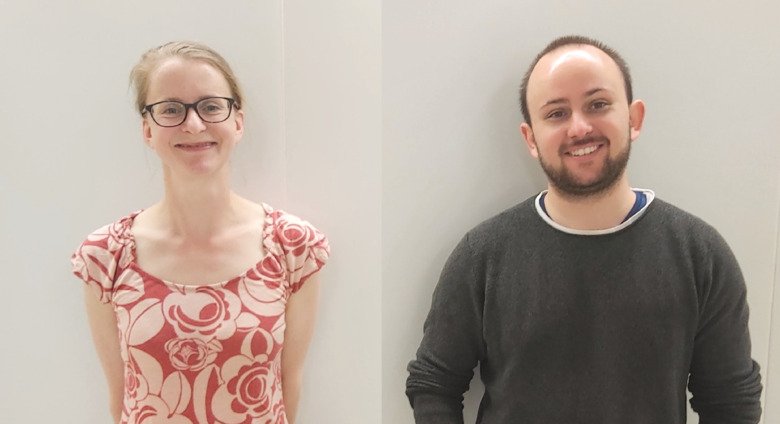Illuminating cell surface receptors

Cell surface receptors are essential for the communication of human cells. Simon Elsässer’s lab has developed a method to study these proteins on living cells. With very subtle alterations the method allows to label receptors with two different fluorescent probes in defined positions, as the authors show in Cell Reports. This can give detailed insights in how the conformation of a receptor changes as a result of for example drug binding, in the natural setting of the cell membrane.
Human cells sense and communicate via cell surface receptors on their surface. Information about the environment is relayed to the inside of the cell through dynamic changes in their arrangement or conformation. To gain better understanding of these dynamics, researchers have developed a variety of imaging methods that allow them to observe receptors in real time.
Postdoctoral Researcher Birthe Meineke and Master Student Johannes Heimgärtner have jointly developed a method in Simon Elsässer’s lab to label and image receptors on live cells with two different colors. ‘’Unlike existing live-cell microscopy methods, which typically rely on sizeable fluorescent proteins fused to the receptor, here only two amino acids in the receptor of interest are exchanged for noncanonical amino acids’’, explains Meineke.
‘’These two synthetic building blocks act as chemical handles, each compatible with a different fluorescent dye, using so-called bioorthogonal chemistry’’ adds Heimgärtner.
The method allows for two differently colored dyes to be installed on live cells in almost any position of the receptor. Hence, fluorescent assays can be developed that not only read out the localization of the receptor, but also report on conformational changes involved in sensing the environment and transducing extracellular signals to the cells’ interior.
Studying drug targets in their natural setting on living cells
Many receptors, such as the large family of G-protein coupled receptors, are important drug targets. Mechanistic insight into the action of drugs on those receptors has so far predominantly been collected on purified receptors in an in vitro environment. The new method, successfully demonstrated by the team on a G-protein coupled receptor and a Notch receptor, expands the possibilities to study natural behavior and pharmacology of receptors in their native setting in the membrane of live cells.
Funding
The study was funded by Karolinska Institutet/Science for Life Laboratory SFO in Molecular Biosciences, Vetenskapsrådet (2015-04815), Ming Wai Lau Center for Reparative Medicine, Ragnar Söderbergs Stiftelse, Knut och Alice Wallenbergs Stiftelse (2017.0276).
Publication
''Site-specific incorporation of two noncanonical amino acids for two-color bioorthogonal labeling and crosslinking of proteins on live mammalian cells''. Birthe Meineke, Johannes Heimgärtner, Jürgen Eirich, Michael Landreh, and Simon J. Elsässer. Cells Reports. Online June 23 2020, doi: 10.1016/j.celrep.2020.107811.
